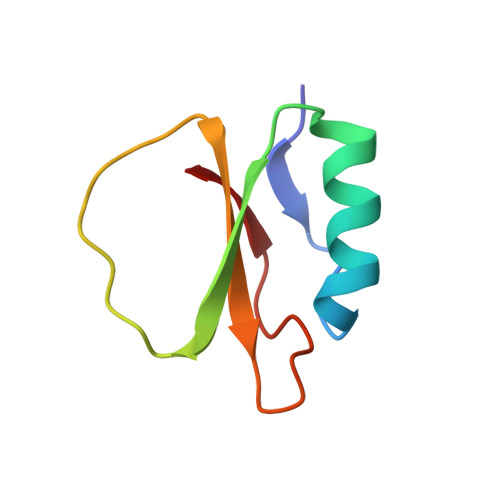Effect of cavity-creating mutations in the hydrophobic core of chymotrypsin inhibitor 2.
Jackson, S.E., Moracci, M., elMasry, N., Johnson, C.M., Fersht, A.R.(1993) Biochemistry 32: 11259-11269
- PubMed: 8218191
- DOI: https://doi.org/10.1021/bi00093a001
- Primary Citation of Related Structures:
1COA - PubMed Abstract:
Hydrophobic residues in the core of a truncated form of chymotrypsin inhibitor 2 (CI2) have been mutated in order to measure their contribution to the stability of the protein. The free energy of unfolding of wild-type and mutants was measured by both guanidinium chloride-induced denaturation and differential scanning calorimetry. The two methods give results for the changes in free energy on mutation that agree to within 1% or 2%. The average change in the free energy of unfolding (+/- standard deviation) for an Ile-->Val mutation is 1.2 +/- 0.1 kcal mol-1, for a Val-->Ala mutation 3.4 +/- 1.5 kcal mol-1, and for either an Ile-->Ala or a Leu-->Ala mutation 3.6 +/- 0.6 kcal mol-1. This gives an average change in the free energy of unfolding for deleting one methylene group of 1.3 +/- 0.5 kcal mol-1. Two significant correlations were found between the change in the free energy of unfolding between wild-type and mutant, delta delta GU-F, and the environment of the mutated residue in the protein. The first is between delta delta GU-F and the difference in side-chain solvent-accessible area buried between wild-type and mutant (correlation coefficient = 0.81, 10 points). The second and slightly better correlation was found between delta delta GU-F and N, the number of methyl/methylene groups within a 6-A radius of the hydrophobic group deleted (correlation coefficient = 0.84, 10 points). The latter correlation is very similar to that found previously for barnase, suggesting that this relationship is general and applies to the hydrophobic cores of other globular proteins. The combined data for C12 and barnase clearly show a better correlation with N (correlation coefficient = 0.87, 30 points) than with the change in the solvent-accessible surface area (correlation coefficient = 0.82, 30 points). This indicates that the packing density around a particular residue is important in determining the contribution the residue makes to protein stability. In one case, Ile-->Val76, a mutation which deletes the C delta 1 methyl group of a buried side chain, a surprising result was obtained. This mutant was found to be more stable than wild-type by 0.2 +/- 0.1 kcal mol-1. We have solved and analyzed the crystal structure of this mutant and find that there are small movements of side chains in the core, the largest of which, 0.7 A, is a movement of the side chain that has been mutated.(ABSTRACT TRUNCATED AT 400 WORDS)
Organizational Affiliation:
MRC Unit for Protein Function and Design, Cambridge IRC for Protein Engineering, U.K.














